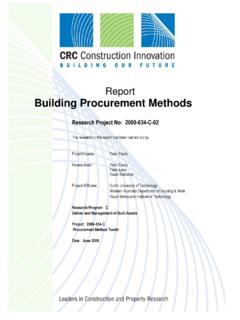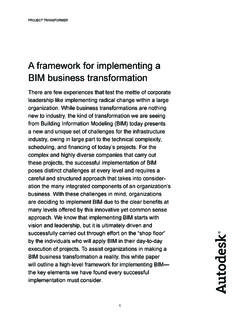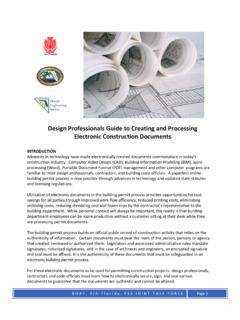Transcription of National Guidelines for Digital Modelling
1 National Guidelines for Digital Modelling Construction Innovation partners June 2008 - July 2009. Transport and Main Roads Employment, Economic Development and Innovation National Guidelines for Digital Modelling Pty Ltd 2009. Cooperative Research Centre for Construction Innovation Level 9, L Block, QUT Gardens Point 2 George Street, Brisbane, Qld, 4000 Australia Telephone: +61 7 3138 1393. Web: The information provided in this document is for information only. All intellectual property in the ideas, concepts and design for this publication belongs to Pty Ltd. The authors, the Cooperative Research Centre for Construction Innovation, Pty Ltd, and their respective boards, stakeholders, officers, employees and agents make no representation or warranty concerning the accuracy or completeness of the information in this work.
2 To the extent permissible by law, the aforementioned persons exclude all implied conditions or warranties and disclaim all liability for any loss or damage or other consequences howsoever arising from the use of the information in this book. First published 2009 by the Cooperative Research Centre for Construction Innovation, for Pty Ltd. For further information on Construction Innovation publications, please visit: Recommended Retail Price $ (incl. GST). ISBN 978-0-9803503-0-2. Cover credit: Architectus + Ingenhoven, BIM Management The 1 Bligh project is a landmark for its use of BIM technology to achieve high ESD outcomes (a Six Star Green Star Rating is targeted), coordination and optimisation of the construction process.
3 The cover image shows the multi- service coordination of blackwater treatment, mechanical services, fire and hydraulic services in the basement of the building . This publication is printed by Printpoint using soy-based inks. Printpoint are FSC certified and use a waterless National Guidelines for Digital Modelling printing technique which produces superior colour and eliminates the use of hazardous, ozone-depleting isoprophyl alcohol. <Printpoint to insert FSC logo here>. The paper stock used is FSC Mixed Sources Mega Recycled Silk which is manufactured acid and element chlorine free from an ISO 14001 accredited supplier. The pulp is from well-managed forests, controlled sources and recycled wood or fibre.
4 Ii Foreword These National Guidelines and Case Studies for Digital Modelling are the outcomes from one of a number of building information Modelling (BIM)-related projects undertaken by the CRC for Construction Innovation. Since the CRC opened its doors in 2001, the industry has seen a rapid increase in interest in BIM, and widening adoption. These Guidelines and case studies are thus very timely, as the industry moves to model-based working and starts to share models in a new context called integrated practice. Governments, both federal and state, and in New Zealand are starting to outline the role they might take, so that in contrast to the adoption of 2D CAD in the early 90s, we ensure that a National , industry-wide benefit results from this new paradigm of working.
5 Section 1 of the Guidelines give us an overview of BIM: how it affects our current mode of working, what we need to do to move to fully collaborative model-based facility development. The role of open standards such as IFC is described as a mechanism to support new processes, and make the extensive design and construction information available to asset operators and managers. Digital collaboration modes, types of models, levels of detail, object properties and model management complete this section. It will be relevant for owners, managers and project leaders as well as direct users of BIM. Section 2 provides recommendations and guides for key areas of model creation and development, and the move to simulation and performance measurement.
6 These are the more practical parts of the Guidelines developed for design professionals, BIM managers, technical staff and in the field' workers. The Guidelines are supported by six case studies including a summary of lessons learnt about implementing BIM in Australian building projects. A key aspect of these publications is the identification of a number of important industry actions: the need for BIM-compatible product information and a National context for classifying product data; the need for an industry agreement and setting process-for-process definition; and finally, the need to ensure a National standard for sharing data between all of the participants in the facility-development process.
7 National Guidelines for Digital Modelling John Mitchell David Parken Chairman, CEO, buildingSMART Australian Institute of Australasia Architects buildingSMART. International Alliance for Interoperability iii Contents Introduction and structure of building information Integrated Sharing Industry Foundation Changing context of project Implications for project delivery with Project collaboration New methods of practice integrated project delivery'..4. The Guidelines context: Why the need for Guidelines ?..5. The potential of Digital Quality of models: Well-formed model Types and uses of Model usage over whole building life Model development Object data Modelling Digital Modelling : 1B - Intelligent 3D Digital collaboration: 2A One-way Digital collaboration: 2B Two-way New types of jobs and Challenges for BIM implementation (issues beyond the Guidelines ).
8 17. Disruptive vs evolving Model user's differing views and expectations of model Need for Australian object Product information and Emerging building information classification information database National Guidelines for Digital Modelling Management of file Sharing Legal, insurance and practice Slow adoption in Software to address local Emerging developments in iv Model creation and Modelling Model Model Model BIM project definition and Who is involved?..26. What models are required and why?..27. When are the models needed?..27. What should the models contain?..28. How are the models to be exchanged?..29. Who will be managing the process? The role of the project model An example of set-up Guidelines for a large scale multi- building Architectural Structural Mechanical, electrical and plumbing (MEP) Electrical Hydraulics Discipline Modelling , analysis and Project definition, planning and Document existing site Architectural Phase 0 Briefing and Phase 1 Conceptual design Phase 2 Schematic design Phases 3 and 4 Developed design and contract document Structural Modelling , analysis, design and production MEP Modelling , analysis, design and production National Guidelines for Digital Modelling Cost planning and quantity Construction Facilities management/as-built v Appendix 1.
9 Model checking and Model Data on building Space compliance with project Duplicate and coincidental model Incorrect object Clash Version comparison of models: Reporting Code compliance egress, accessibility and code Developing custom Rule Appendix 2: information Delivery Manual ..54. IDM 1. Process 2. Exchange 3. Functional 4. Business 5. Verification Appendix 3: Window property sets Appendix 4: Model servers ..57. Appendix 5: Export Revit IFC import/export Model object Universities, government and industry Regular web-based Technical web-based National Guidelines for Digital Modelling BIM-related software Analysis, simulation and Model merging and Articles and vi Preface Since 2001, the Cooperative Research Centre for Construction Innovation has been committed to leading the Australian property, design, construction and facility management industry in collaboration and innovation.
10 We have been dedicated to disseminating practical research outcomes to our industry to improve business practice and enhance the competitiveness of our industry. Developing applied technology and management solutions, and delivering education and relevant industry information is what our CRC is all about. We look forward to your converting the results of this applied research project into tangible outcomes and working together in leading the transformation of our industry to a new era of enhanced business practices, safety and innovation. John V McCarthy AO Dr Keith Hampson Chair Chief Executive Officer CRC for Construction Innovation CRC for Construction Innovation National Guidelines for Digital Modelling vii Acknowledgments The CRC for Construction Innovation provided the major funding, industry research leadership and coordinated the development of National Guidelines for Digital Modelling and accompanying Case Studies.


